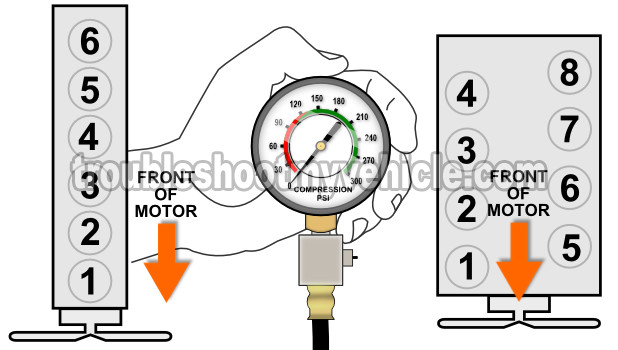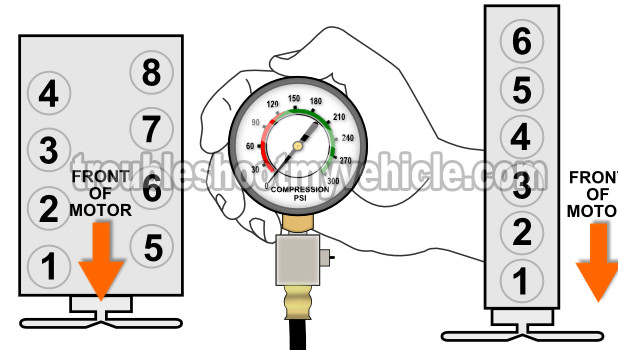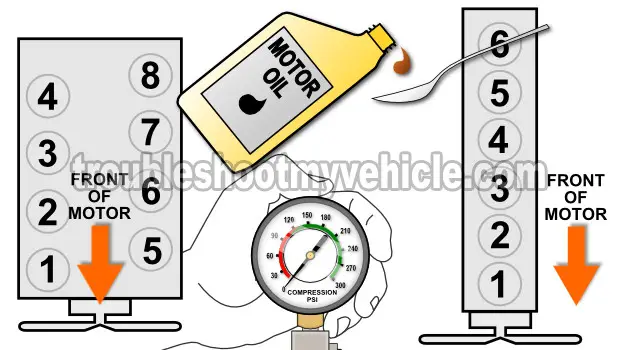
In this tutorial, I'm gonna' show you the 'ins and outs' of doing a compression test on your Ford 4.9L engine (inline 6 cylinder), 5.0L engine, or 5.8L engine. More importantly, I'll show you how to interpret your compression test results.
Why do an engine compression test? Well, it may help you to find out if the engine is shot and/or if you have one or several 'dead' cylinders.
If you have no or very low engine compression across all cylinders, then this will cause a 'cranks but does not start' condition. If you have low engine compression one or several cylinders, this will cause an engine miss when the engine is idling or accelerating your Ford down the road.
I'm also gonna' include the test info you need to do a 'wet' engine compression test on your 5.0L engine (4.9L engine or 5.8L engine) and find out if the low compression test result you got is due to worn out cylinder head valves or worn engine piston rings.
Contents of this tutorial:
ES ![]() You can find this tutorial in Spanish here: Cómo Probar La Compresión Del Motor (Ford 4.9L, 5.0L, 5.8L) (at: autotecnico-online.com).
You can find this tutorial in Spanish here: Cómo Probar La Compresión Del Motor (Ford 4.9L, 5.0L, 5.8L) (at: autotecnico-online.com).
Symptoms Of An Engine Compression Problem
Engine compression issues usually fall into one of two categories:
- A low compression is in some but not all cylinders.
- 0 (zero) PSI compression in some or all cylinders.
Regardless of whether the engine has a low compression or zero PSI compression issue, you'll see a range of symptoms that will affect performance, reliability, and drivability. Some of the most common symptoms you'll see include:
- Hard Starting or No Start: Engines with low compression may exhibit difficulty starting or may fail to start altogether. This is because insufficient compression hinders the engine's ability to generate the pressure necessary for combustion.
- Poor Engine Performance: Vehicles with low compression may experience poor acceleration, hesitation, or rough idling. This is due to incomplete combustion resulting from inadequate pressure within the cylinders.
- Misfiring: Low compression can lead to misfires, where the air-fuel mixture fails to ignite properly in one or more cylinders. This can cause noticeable engine sputtering, shaking, or a loss of power while driving.
- Reduced Power and Performance: Engines with low compression may lack power and overall performance. This can result in sluggish acceleration, decreased fuel efficiency, and a general sense of weakness or lack of responsiveness from the engine.
- Excessive Oil Consumption: Low compression can contribute to increased oil consumption as oil may leak past worn piston rings or valves into the combustion chamber. This can lead to fouled spark plugs, excessive exhaust smoke, and a noticeable decrease in oil level between oil changes.
- Audible Engine Noise: Engines with low compression may produce unusual noises such as knocking, rattling, or tapping, especially during acceleration or under load. These noises can indicate internal damage or mechanical issues affecting compression levels.
Which Compression Tester Should I Buy?
There are many engine compression testers to choose from and many places to buy them. Here are the ones I recommend:
Disclosure: As an Amazon Associate, I earn from qualifying purchases. If my tutorials help you, using these links is an easy way to support the site at no extra cost to you. Thank you!
TEST 1: 'Dry' Engine Compression Test

One of the things, that's gonna' help you to successfully interpret the results of your compression test, is knowing which cylinder is which.
And so, in the illustration, you'll see two images that will help you identify the number of the engine whether it's a V8 (5.0L, 5.8L) or an L6 (4.9L).
If you don't own a compression test gauge, you can borrow one from your local parts store (for a small cash deposit which they'll return when you return the it), or you can buy your own. For suggestions, take a look at: Which Compression Tester Should I Buy?
OK, to get this show on the road, I'll first explain the test steps. At the end of the test steps, you'll find two possible test results that will help you to interpret your specific test results.
NOTE: If the engine has been running for an extended amount of time, then let it cool down for at least 45 minutes before removing the spark plugs.
Let's get started:
- 1
Warm up the engine. It's standard operating procedure to perform the compression test with the engine slightly warmed up but not hot.
If your specific Ford 5.0L engine (4.9L engine or 5.8L engine) doesn't start, don't worry. You can continue with the other steps. - 2
Disable the fuel system. You can do this by simply disconnecting the fuel pump relay.
NOTE: It's important to disable the fuel system so that fuel is not injected into the engine cylinders while you're compression testing the engine. - 3
Disable the ignition system. This can be done by disconnecting the ignition coil from its electrical connector.
NOTE: It's important to disable the ignition system since you can not have it firing off spark while you're compression testing the engine. - 4
Remove all six (or eight) spark plugs.
As you're taking them out, be careful and don't drop any of them on the floor, or you could cause the spark plug's ceramic insulator to break, and this will cause a misfire! - 5
Thread the engine compression gauge into the spark plug hole for the number 1 engine cylinder. Hand tighten the compression gauge only! Do not use any type of tool to get it tight.
- 6
Crank the engine once the compression gauge is threaded into the spark plug hole with the help of a helper.
- 7
Once the needle stops climbing, have your helper stop cranking the engine.
- 8
Write down the number at which the needle stopped (and the number of the engine cylinder) and then repeat steps 1 thru' 7 on the other cylinders.
Let's examine your test results:
CASE 1: All cylinders had 0 PSI. This test result tells you that the engine has an internal mechanical problem.
The most common cause of this condition is a broken timing chain.
Your next step should be to check the condition of the timing chain. I would also recommend that you check for a blown head gasket.
CASE 2: One or more cylinders had a low compression value compared to the others. This could be normal or it could be causing a problem.
To find out if the compression values are normal or not, go to: How To Interpret The Engine Compression Test Results.
CASE 3: All compression values were similar and above 120 PSI. This lets you know that a compression problem is not behind the no-start or misfire problem you're trying to troubleshoot.
How To Interpret The Engine Compression Test Results
For starters, let me tell you that you're not gonna' see the exact same compression value on each of the 6 or 8 cylinders you tested on your Ford 4.9L engine, 5.0L engine or 5.8L engine and this is normal.
What is not normal is to have one or several a compression values that are radically different than the average compression of the good cylinders.
Keeping the above in mind, this means that compression between cylinders should not vary more than 15%. If you're scratching your head and wondering how to do this, don't worry, this is how you can find out:
- STEP 1: Multiply the highest compression value by 0.15 (this is the decimal value of 15%).
- STEP 2: Round off the result (for example: 25.6 would become 26).
- STEP 3: Subtract the result (the number that was rounded off) from the highest compression value.
- ANSWER: The result of this subtraction is the lowest possible compression value any cylinder can have.
NOTE: You can also use my online low compression calculator if you want to avoid doing the math. You can find it here: Online Low Engine Compression Calculator (at: easyautodiagnostics.com).
To make better sense of this calculation, I'll give you a specific example on how to do this 15% calculation. Let's say that my 5.0L Ford Crown Victoria gave me following compression values when I did a compression test on all 8 cylinders:
| Cylinder | Pressure |
|---|---|
| #1 | 175 |
| #2 | 170 |
| #3 | 170 |
| #4 | 140 |
| #5 | 165 |
| #6 | 170 |
| #7 | 155 |
| #8 | 160 |
The next step is to do the math:
- STEP 1: 175 x 0.15 = 26.25.
- STEP 2: 26.25 = 26 (rounded to nearest one).
- STEP 3: 175 - 26 = 149.
- ANSWER: 149 PSI. Any cylinder with this compression (or lower) value will misfire.
Since cylinder #4 gave me a compression value of 140 PSI, I now know that this is the one causing the misfire I'm trying to diagnose.
The next step, after finding out that a cylinder's low engine compression value is not within range, is to do a 'wet' compression test on it. Go to: TEST 2: 'Wet' Compression Test.
TEST 2: 'Wet' Compression Test

If you've gotten a very low compression reading from any one cylinder on your 5.0L engine (4.9L engine or 5.8L engine), the next step is to add a little bit of engine oil (to that cylinder) and re-check its compression to see if the compression pressure will go up or not.
Adding engine oil and checking the cylinder's compression is known as a 'wet' compression test. This 'wet' compression test will help you determine if the piston rings or cylinder head valves are the ones causing the low or no compression reading you obtained in TEST 1.
The amount of oil you're gonna' add is about 2 tablespoons. If the piston rings are worn (and the cause of the low compression reading), this oil will cause your compression tester to record a higher compression value.
Now, since oil could never help seal the cylinder head valves, if the compression value does not go up (from the previous one), then you'll know that the problem lies in the cylinder head valves.
OK, this is what you need to do:
- 1
Add about 2 tablespoons of engine oil to the cylinder that reported low or no compression in the 'dry' compression test.
- 2
Install the compression tester. Once again, hand-tighten the compression tester.
- 3
Crank the engine when all is ready.
- 4
Once the needle on your compression tester stops climbing, have your helper stop cranking the engine.
- 5
You'll get one of two results: Either the compression value will go up (from the one you recorded before) or it will stay the same.
Let's take a look at what your test results mean:
CASE 1: The compression value shot up. This tells you that the piston compression rings are worn out and thus the problem is in the bottom end of your 5.0L engine (4.9L engine or 5.8L engine).
CASE 2: The compression value stayed the same. This confirms that the problem is in the cylinder head valves.
Why An Engine Compression Test?
One of the things that can cause a misfire condition (also known as a miss or dead cylinder), is an engine cylinder or engine cylinders that produce less than normal compression.
When this happens, not matter what gets replaced (like spark plugs, spark plug wires, fuel injectors), nothing solves the miss (misfire). This is when the compression test comes in to save the day.
Over the years, I have solved many unsolvable misfire codes, rough idle, lack of power issues by doing a simple engine compression test and if you're faced with something similar, I highly recommend doing an engine compression test.
Related Test Articles
To see all of the Ford 4.9L, 5.0L, 5.8L specific tutorials, go to: Ford 4.9L, 5.0L, 5.8L Index Of Articles.
Here's a sample of the tutorials you'll find in the index:
- Testing A Blown Head Gasket (Ford 4.9L, 5.0L, 5.8L).
- Ignition Coil Test -No Spark No Start Tests (Ford 4.9L, 5.0L, 5.8L).
- No Start Troubleshooting Tests.
- Distributor Mounted Ignition Control Module Test (at: easyautodiagnostics.com).
- Fender Mounted Ignition Control Module Test (at: easyautodiagnostics.com).

If this info saved the day, buy me a beer!




